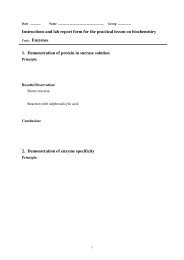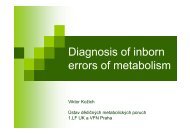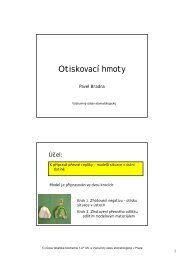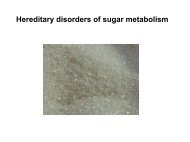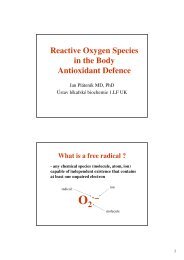You also want an ePaper? Increase the reach of your titles
YUMPU automatically turns print PDFs into web optimized ePapers that Google loves.
Inorganic <strong>compounds</strong><br />
Here we present a <strong>list</strong> <strong>of</strong> simple <strong>inorganic</strong> <strong>compounds</strong> whose knowledge is required for the credit tests ending<br />
the winter semester medical chemistry courses in the first year English class, programs general medicine and<br />
dentistry. The purpose <strong>of</strong> the <strong>list</strong> is to state explicitly what we consider as the ‘background’ knowledge for the<br />
nomenclature, ionic equations, calculation tasks etc. contained in the test; but is not intended as any<br />
substitute for course information on biomedically significant <strong>inorganic</strong> <strong>compounds</strong>.<br />
1. Oxides:<br />
Formula<br />
CO<br />
CO 2<br />
N 2 O<br />
NO<br />
NO 2<br />
N 2 O 5<br />
SO 2<br />
SO 3<br />
CaO<br />
MgO<br />
Al 2 O 3<br />
SiO 2<br />
ZnO<br />
Cu 2 O<br />
CuO<br />
FeO<br />
Fe 2 O 3<br />
CrO 3<br />
MnO 2<br />
Mn 2 O 7<br />
English name<br />
carbon monoxide<br />
carbon dioxide<br />
dinitrogen oxide, nitrogen(I) oxide, nitrous oxide<br />
nitrogen oxide, nitrogen(II) oxide, nitric oxide<br />
nitrogen dioxide, nitrogen(IV) oxide<br />
dinitrogen pentaoxide, nitrogen(V) oxide<br />
sulfur dioxide, sulfur(IV) oxide, sulfurous oxide<br />
sulfur trioxide, sulfur(VI) oxide, sulfuric oxide<br />
calcium oxide (lime)<br />
magnesium oxide<br />
aluminium oxide (alumina)<br />
silicon dioxide, silicon(IV) oxide (silica)<br />
zinc oxide<br />
copper(I) oxide, cuprous oxide<br />
copper(II) oxide, cupric oxide<br />
iron(II) oxide, ferrous oxide<br />
iron(III) oxide, ferric oxide<br />
chromium trioxide, chromium(VI) oxide<br />
manganese dioxide, manganese(IV) oxide<br />
dimanganese heptoxide, manganese(VII) oxide<br />
2. Peroxides:<br />
Formula<br />
H 2 O 2<br />
English name<br />
hydrogen peroxide<br />
3. Hydroxides:<br />
Formula<br />
NaOH<br />
KOH<br />
Ca(OH) 2<br />
Ba(OH) 2<br />
Al(OH) 3<br />
Fe(OH) 2<br />
Fe(OH) 3<br />
Cu(OH) 2<br />
NH 4 OH<br />
English name<br />
sodium hydroxide<br />
potassium hydroxide<br />
calcium hydroxide<br />
barium hydroxide<br />
aluminium hydroxide<br />
iron(II) hydroxide, ferrous hydroxide<br />
iron(III) hydroxide, ferric hydroxide<br />
copper hydroxide<br />
ammonium hydroxide (aqueous ammonia)<br />
© Institute <strong>of</strong> Medical Biochemistry, First Faculty <strong>of</strong> Medicine, Charles University in Prague 2006 1
4. Hydracids:<br />
Formula<br />
HF<br />
HCl<br />
HBr<br />
HI<br />
HCN<br />
H 2 S<br />
English name<br />
hydr<strong>of</strong>luoric acid, hydrogen fluoride<br />
hydrochloric acid, hydrogen chloride<br />
hydrobromic acid, hydrogen bromide<br />
hydroiodic acid, hydrogen iodide<br />
hydrocyanic acid, hydrogen cyanide<br />
hydrosulfuric acid, hydrogen sulfide<br />
5. Oxoacids and thioacids:<br />
Formula English name<br />
H 3 BO 3 boric acid<br />
H 2 CO 3 carbonic acid<br />
HOCN cyanic acid<br />
HSCN thiocyanic acid<br />
HNO 2 nitrous acid<br />
HNO 3 nitric acid<br />
H 3 PO 4 phosphoric acid<br />
H 2 SO 3 sulfurous acid<br />
H 2 SO 4 sulfuric acid<br />
H 2 S 2 O 3 thiosulfuric acid<br />
HClO hypochlorous acid<br />
HClO 2 chlorous acid<br />
HClO 3 chloric acid<br />
HClO 4 perchloric acid<br />
H 2 CrO 4 chromic acid<br />
H 2 Cr 2 O 7 dichromic acid<br />
HMnO 4 permanganic acid<br />
6. Salts:<br />
Salts are binary <strong>compounds</strong>. Various combinations <strong>of</strong> anions (derived from an acid), and cations (typically a<br />
metal, derived from a metal hydroxide) <strong>list</strong>ed below should be considered.<br />
ANIONS<br />
Formula English name Charge<br />
F − fluoride −1<br />
Cl − chloride −1<br />
Br − bromide −1<br />
I − iodide −1<br />
CN − cyanide −1<br />
S 2− sulfide −2<br />
HS − hydrogen sulfide −1<br />
2−<br />
CO 3 carbonate −2<br />
−<br />
HCO 3 hydrogen carbonate −1<br />
OCN − cyanate −1<br />
SCN − thiocyanate (rhodanide) −1<br />
© Institute <strong>of</strong> Medical Biochemistry, First Faculty <strong>of</strong> Medicine, Charles University in Prague 2006 2
−<br />
NO 2 nitrite −1<br />
−<br />
NO 3 nitrate −1<br />
3−<br />
PO 4 phosphate (tertiary phosphate) −3<br />
2−<br />
HPO 4 hydrogen phosphate (secondary phosphate) −2<br />
−<br />
H 2 PO 4 dihydrogen phosphate (primary phosphate) −1<br />
2−<br />
SO 3 sulfite −2<br />
−<br />
HSO 3 hydrogen sulfite −1<br />
2−<br />
SO 4 sulfate −2<br />
−<br />
HSO 4 hydrogen sulfate −1<br />
2−<br />
S 2 O 3 thiosulfate −2<br />
ClO − hypochlorite −1<br />
−<br />
ClO 2 chlorite −1<br />
−<br />
ClO 3 chlorate −1<br />
−<br />
ClO 4 perchlorate −1<br />
2−<br />
CrO 4 chromate −2<br />
2−<br />
Cr 2 O 7 dichromate −2<br />
−<br />
MnO 4 permanganate −1<br />
CATIONS<br />
Formula English name Charge<br />
Li + lithium +1<br />
Na + sodium +1<br />
K + potassium +1<br />
Ca 2+ calcium +2<br />
Mg 2+ magnesium +2<br />
Ba 2+ barium +2<br />
Al 3+ aluminium +3<br />
Pb 2+ lead(II) +2<br />
Pb 4+ lead(IV) +4<br />
Bi 3+ bismuth +3<br />
Ag + silver +1<br />
Cr 3+ chromium(III) +3<br />
Co 2+ cobalt(II) +2<br />
Ni 2+ nickel(II) +2<br />
Zn 2+ zinc +2<br />
Mn 2+ manganese(II) +2<br />
Cu + copper(I), cuprous +1<br />
Cu 2+ copper(II), cupric +2<br />
Fe 2+ iron(II), ferrous +2<br />
Fe 3+ iron(III), ferric +3<br />
2+<br />
Hg 2 mercury(I), mercurous +2<br />
Hg 2+ mercury(II), mercuric +2<br />
+<br />
NH 4 ammonium +1<br />
The salts or hydroxides can be hydrated, e.g. CuSO 4 . 5H 2 O, Ba(OH) 2 . 8H 2 O.<br />
© Institute <strong>of</strong> Medical Biochemistry, First Faculty <strong>of</strong> Medicine, Charles University in Prague 2006 3
From basic (oxide/hydroxide) salts, only the basic bismuth nitrate, formula BiNO 3 (OH) 2 , or<br />
BiNO 3 (O), is <strong>of</strong> significance for us.<br />
7. Coordination <strong>compounds</strong>:<br />
Formula<br />
K 4 [Fe(CN) 6 ]<br />
K 3 [Fe(CN) 6 ]<br />
Na 2 [Fe(CN) 5 NO]<br />
[Ag(NH 3 ) 2 ] +<br />
[Cu(NH 3 ) 4 ] 2+<br />
English name<br />
potassium hexacyan<strong>of</strong>errate(II),<br />
potassium ferrocyanide<br />
potassium hexacyan<strong>of</strong>errate(III),<br />
potassium ferricyanide<br />
sodium pentacyanonitrosylferrate(III),<br />
sodium nitroprusside<br />
diamminesilver cation<br />
tetraamminecopper(II) cation<br />
© Institute <strong>of</strong> Medical Biochemistry, First Faculty <strong>of</strong> Medicine, Charles University in Prague 2006 4



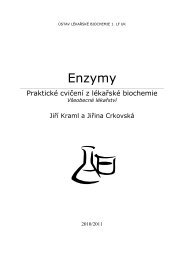
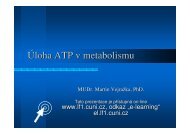
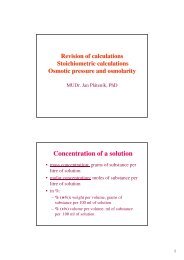
![(Microsoft PowerPoint - ATP angl.ppt [Re\236im kompatibility])](https://img.yumpu.com/46799556/1/190x134/microsoft-powerpoint-atp-anglppt-re236im-kompatibility.jpg?quality=85)

